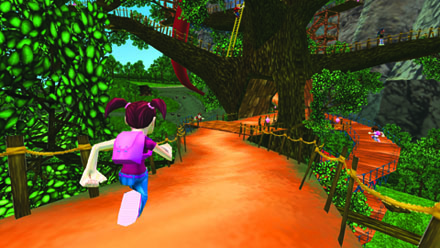[The following is an article I wrote for the August 2008 issue of Tech & Learning Magazine. For those unfamiliar with this monthly magazine, it’s a great resource for education technology leaders. It provides helpful information on how to implement technology into schools, and is tailor-made to meet the special needs of a professional educator.]
For an audio recording of this interview, click here.

Mitchel Resnick is a researcher, inventor and professor at MIT’s Media Laboratory in Cambrige Massachusetts and the founder of the Lifelong Kindergarten Group at MIT. He is the lead innovator behind many cutting-edge learning technologies and projects for children including the , PicoCrickets, and the wildly successful consumer product, Lego Mindstorms.
In this interview Mitchel shares his experiences about his latest online learning product for kids called Scratch. Scratch is a unique digital creativity tool for kids which helps facilitate expression, communication, concepts in interactivity and programming, presentation development, and community-based learning. It consists of an offline application used to create projects, and an online gallery for sharing those projects with other community members and the world. This interview was conducted in the Spring of 2008 and has been edited for clarity purposes.
ST: Can you tell me about the meaning behind your group name, the Lifelong Kindergarten Group?
MR: In our group we’re especially interested in how to help people develop as creative thinkers. It’s our belief that one of the keys to success in the future is going to be one’s ability to think and act creatively. We’re living in a world where things are changing quickly and because of that people need to be able to come up with innovative solutions to unexpected problems.
If our goal is to help people develop as creative thinkers, we then ask ourselves “Well, where can we draw inspiration from? What are good models of how to help people develop as creative thinkers?” As we looked around, we found lots of inspiration from the ways children learn in Kindergarten, especially with traditional Kindergarten. Kindergartens are in the process of changing, but at least in the traditional Kindergarten from its early roots almost 200 years ago, Kindergarten has been a time where kids are constantly engaged in creating things in collaboration with one another in a playful way. Whether they’re building towers out of wooden blocks to make a city, or making pictures with crayons and finger paints, kids in Kindergartens are constantly coming up with ideas, creating things playfully with one another. We’ve seen that that approach is a good way for learning some important concepts in Kindergarten, like learning about number and shape and size and color, but it’s also a very good method to help kids develop as creative thinkers.
By looking at the way children learn in Kindergarten we developed what I call the “creative learning spiral.” In many of the best creative thinking experiences you start with imagination, you come up with an idea, you create something based on your idea, you play and experiment with that idea, you share it with others, you talk about it with them, they try it out, and they give you feedback. Based on that experience, you reflect upon your idea, you think about what happened, and that gives you new ideas. Then you’re right back again at the beginning with imagining – at which point, you keep on spiraling out with new ideas based on this concept of “imagine, create, play, share, reflect, and imagine.” We can see this spiraling concept working really well in most Kindergartens. So we ask ourselves “Why cant we take this same approach to learning and bring it to learners of all ages?” Hence the name of our group, Lifelong Kindergarten.
Kindergarten has been around for a long time. Why hasn’t the Kindergarten approach to learning been adopted for learners of all ages? My thinking is that it’s been difficult to spread that Kindergarten approach through older grades in school and through the continual learning experiences as we get older because we haven’t had the right media, the right technologies, and the right tools.
Crayons, fingerpaints and wooden blocks are great for learning Kindergarten concepts like number, shape, size, and color. As you get older and you want to learn more advanced ideas, then crayons, fingerpaints and wooden blocks are not enough. People then shift to a more “transmission” approach to learning, where we try to deliver information to students in a classroom as a way of helping students learn new things.
This is where I think new technologies can make a big difference. My feeling is if we use new technologies the right way, we can extend the Kindergarten approach to learning to learners of all ages. What we want to do in our Lifelong Kindergarten group is develop new technologies that are in the spirit of crayons, fingerpaints and wooden blocks used in Kindergarten. By using these new technologies, want to allow learners of all ages to work on personally meaningful projects and to continue to learn in that Kindergarten style but to learn more advanced ideas and to work on more advanced projects.
ST: This is a recurring theme with the other projects you have been involved with. Not just Scratch, but also PicoCrickets and the Computer Clubhouse as well.
MR: Yes. The Lifelong Kindergarten Group has been the name of my research group for maybe ten or fifteen years now. We’ve worked on many different projects under that banner. The theme of Lifelong Kindergarten is our broad vision. Within that broad vision we’re always working on different projects. Sometimes its developing new technologies that will help people continue to experiment, explore and express themselves in a Kindergarten style. Sometimes its creating new sites or contexts where we can experiment with how people learn, like the after school Computer Clubhouse settings we started. We’re creating technologies, activities, and environments, both physical and online, that help support this Kindergarten style of learning. Our feeling is that you need lots of different things to support the Kindergarten style of learning. Any one technology is not going to do it.
ST: Kind of a diverse curriculum for older ages?
MR: Yes, and for us to support that approach, we need people with lots of different backgrounds. They can’t just be a bunch of technologists building the technology. It requires not just computer scientists, but also psychologists, educators, designers, and people with expertise in content areas like math and sciences. It also requires people who are not just thinking about developing technologies but who are developing activities and developing different types of real world settings to support all of this.
ST: And you would need theorists as well.
MR: Yes.
ST: I know the work of Seymour Papert has had a strong impact on your thinking and the development of the Computer Clubhouse, Crickets, and Scratch. What areas of Seymour’s work have had the biggest influence on you?
MR: Well, a few different things. It’s from Seymour that I received a real appreciation about the importance of the design experience being interwoven with the learning experience. Many of our best learning experiences come about when we’re actively engaged in designing and creating things. With almost all of our projects, we’re always thinking “How can we engage people in creating and designing?” because we feel many of the best learning experiences come about when you’re creating and designing. That’s one important thing that I’ve learned from Seymour.
A second thing that was a very big influence for me is the importance of supporting a very wide range of different learners. I find that too many toys and educational activities are designed for a very particular type of learner. They might do a good job of supporting that particular type of learner but unfortunately it means that only certain types of people are able to get engaged with important ideas. I was very influenced by Seymour’s efforts to try to broaden the range of people who would get engaged in activities. To make sure you take into account that different people have different styles of learning and that they also have lots of different interests. We really try to think about those issues as we design.
Seymour would talk about developing new technologies in terms them having a “low floor” and a “high ceiling.” A low floor means making it easy for people to get started, and a high ceiling can keep them doing more and more advanced and complex things with it. I then extend this metaphor to say it’s also important to have “wide walls.” This means that you can have many different ways of getting engaged in these activities, not just one narrow way of doing it.
Also, the idea of connecting with people’s passions is also something I took away from Seymour. In his book Mindstorms, he starts with a wonderful essay about his own experiences as a child playing with gears. Playing with gears gave him a way of thinking about different mathematical ideas. An important part of this essay was Seymour saying he “fell in love with gears.” That’s the phrasing he uses and I think it’s an important one. It’s not just that he learned about gears, but he fell in love with gears. It’s all about the importance of engaging someone’s passion in what they’re learning. The lesson is not that we should be giving gears to everybody, it’s that we should find out what each person is passionate about.
ST: What insights can you share in how best to make technology more personable, more meaningful and more accessible to kids?
MR: The first thing is to make sure we think of technology in terms of a material that kids can do things with. Too often today, a lot of technology delivers something to the kid. I think too many technologies are trying to create an experience for kids or deliver information to kids. I’d rather think of technology as a material that kids can mold out of their imaginations into things. The more that you give kids control over the technology and allow kids to shape the direction of the technology then it becomes much easier to connect with their personal interests and passions. Giving kids the ability to shape, mold and direct technology allows everyone to shape the technology based on their own interests and passions. I’m always thinking about how we can make the technology in a way that kids are the ones who are deciding which ways to push it. Kids should be pushing the technology, the technology should not be pushing the kid.
ST: Do you find yourself in conversations with educators about the differences between Constructionism and Constructivism or Behaviorism or the learning approach teachers tend to use in class today?
MR: Yes, I certainly find myself in all those discussions.
First of all, the way I think about Piaget‘s term Constructivism, the core idea to recognize is that learners build knowledge structures. Learning is an active process where learners are actively constructing knowledge based on their interactions with the world. In our minds we have lots of pieces of knowledge. Through our interaction with the world we’re actively making new connections and building our understanding. Building understanding is an active process where learners, through their interactions, are constantly constructing an understanding of the world. In a class of 30 students they are all going to be doing somewhat different constructions. It’s an ongoing active process.
Now Seymour Papert, who studied with and worked closely with Piaget, added to this concept with his term Constructionism. This idea says that one of the best ways to help people actively build their knowledge structures is to engage them in constructing things in the world. This can be thought of broadly. It might be constructing a tower out of wooden blocks, constructing a poem with words, or constructing a picture on the computer screen. Those are all ways of constructing in the world. When you talk about Constructionism, Seymour’s main point is that one of the best ways of building knowledge structures is by constructing things in the world. Whenever I construct things in the world, there is this constant feedback, back and forth, that helps me building new ideas. By building new ideas it gives me new ways of thinking about how to make things in the world. It’s this constant cycle of making things in the world, which enables me to make new ideas, which let’s me make new things in the world, which let’s me make new ideas. This is what I see Seymour saying with Constructionism.
I interpret Piaget’s Contructivism as more a theory of how people learn, where Seymour’s Constructionism is more of an approach to learning, it’s a strategy for education. I see them as somewhat different. It’s not that one replaces the other. Constructivism is more about the way people learn and Constructionism is more a suggested strategy, an educational approach, to help people learn.
As I look at the educational community, especially in the educational research community, over the last decade or so, everybody says they’re a Constructivists. Increasingly with teachers, they also say they’re Constructivists and that they’re drawing upon these ideas from Piaget. One thing that I sometimes find frustrating is that people often say they are Constructivists, but if you look at their practices, whether it’s the practice of a teacher in a classroom or the practice of a toy designer, or a media designer, their practices are totally at odds with what I think Constructivism is really about. I worry that it’s a buzz word being tossed around these days. I don’t think people really take it to heart in a serious way.
I should add that, although I feel I’m very influenced by and a strong believer of this Constructivist approach to learning and Seymour’s Constructionist strategies for education, it’s important to be up front about the fact that it’s not easy to carry out a Constructionists approach to learning or to set up an educational approach taking seriously Constructivist ideas. I think that’s one reason why they don’t get followed through as well as I would wish. It’s not that it’s easy to follow through on these approaches. To really respect individual learners and their learning styles and the ways that they go about constructing knowledge is a challenge. Although I think these ideas are very important, and I’m a deep believer in them, I’m also very aware that it’s a challenge to realize them.
ST: Where teachers and students are regularly tested for what they’ve learned within a week, within a month, I wonder if a Constructionists approach to learning can co-exist with all the testing that occurs in these assessment heavy days?
MR: I think it’s challenging. I think the role assessment plays in today’s classroom does make it more difficult to bring about the approach to education I would be most supportive of. I think assessment influences both what we’re helping students learn and how we’re helping students learn. First of all, some of the things I think are most important for students to learn aren’t easy to assess. If we need to have a very clear, often quantitative assessment of what students are learning, some things that I think are very important for students to be learning just don’t enter the classroom because we don’t have good ways of assessing them. But I don’t think that means we should give up on those things because they’re not easy to assess.
It’s a challenge. It is important to be accountable and to make sure what you’re doing is valued and is bringing about important change. I think it’s a dilemma.
Also, what is easiest to assess is knowledge of specific facts and specific skills. If those are the easiest things to assess then often times the curriculum drifts in that direction. If what you’re going to assess people on is specific facts and specific skills then drilling, practicing and memorizing can be a very effective way of achieving those results. Again, I don’t think that’s what the goal should be, but if that is what the goal is, then those approaches to education and learning could be effective. However, I do think this steers a lot of education away from what’s most important.
ST: Where did the inspiration for Scratch come from?
MR: A few different places. Partly it grew out of our long experience with our Computer Clubhouses. We started these after school centers for young people from low-income communities and specifically set them up for young people to learn to express themselves with new technologies.
One thing we found was that kids were very engaged with activities like designing with graphics and images. Photoshop became very popular and kids would grab images with a camera or they would scan an image and then they would put together someone’s head with someone else’s body and make all sorts of great images. But one thing we found was that it was much more difficult for Clubhouse members to create dynamic interactive projects, or to create interactive animations, or to create their own games. We thought that it was unfortunate that they couldn’t do this because a lot of them wanted to create interactive animations, interactive stories, and interactive games. They see a lot of this kind of creative work on the Internet and they want to create it as well, but they didn’t have good tools for doing it on their own. A lot of times they would see things online made with Flash, but Flash really wasn’t made for this audience. A lot of the young people would come into the Clubhouse thinking they could get started with Flash and then learn it was really hard for them to do the kinds things they wanted to do. The right tools didn’t exist out there for them to create what they wanted to create.
We also saw this as a missed learning opportunity. In the process of designing and creating interactive projects there are lots of opportunities for important learning experiences. We saw that there were two problems; kids couldn’t design what they wanted to design and there was this missed learning opportunity. The tools that are out there, like Flash, didn’t really seem to be serving the audience that we were most interested in.
Around this time another source of inspiration came to us through my interactions with Alan Kay. Alan is considered one of the grandfathers of the personal computer and the graphical user interface. He’s also been very interested in children’s learning. Alan had been working on a project called Etoys, which was built on top of a programming language his group had developed called Squeak. When I saw Etoys I was very inspired. It was a media manipulating authoring environment that allowed kids to manipulate media in creative ways.
As I looked at Etoys, I found it to be very exciting but didn’t really think it was going to work with the audience I had in mind. Using the experiences we had gathered over the years from the Computer Clubhouse, and drawing off of my work with Seymour Papert and his work with Logo, we imagined we could take some of the ideas from Alan Kay’s Etoys work and make it more accessible. We wanted to figure out how we could lower the floor and make it easier for kids to get started.
Also, from the beginning, we wanted to think about the community aspect of how people could share their projects with one another and how they could collaborate with one another. We thought this was going to be an important part of the learning process.
Using our experiences from the work of Seymour Papert and the work we had done with the Lego Company on the Lego Mindstorms product, we knew a lot about how to make a graphic programming language for kids. Rather than using this graphic programming language to control things in the physical world, as with Lego Mindstorms, the question became “How do we help kids control things on a screen and also let them share there creations?” That’s how we got started and those were our goals.
We were very lucky to receive a grant from the National Science Foundation to work on this project. We worked on what would become Scratch for about four years, trying out different things, constantly working with kids along the way to see what kids were interested in, what type of tools were intuitive for them, and what would they do with the tools we created. There are a variety of different aspects to the project. We built prototype after prototype to try out with kids and finally we publicly launched Scratch exactly one year ago. It’s been very exciting to have it out in the world and attracting a growing community.
ST: Can you tell me about Scratch’s journey since the moment you made the product available online?
MR: It had a rocky start at the very beginning because there was so much demand. On the first day our server crashed. We had a lot of learning to do in order to deal with the demand. But the problem was stabilized quickly and we’ve been able to support the community well since then.
The things I’m happiest with and most surprised about, I’ve been amazed by the sophistication of the projects that the people have done in Scratch. People created things that are beyond what I imagined could be created with the language we developed. It’s always exciting when you develop a piece of software and then people do things with it that you never imagined could be done with it. For example, people have made these incredibly accurate versions of old video games that are sophisticated in ways that I didn’t realize our software would be able to support. This level of sophistication is very impressive.
Even more so I’ve been impressed with and pleased by the diversity of projects kids have been created. From the beginning we knew we wanted to help kids make interactive games, interactive stories, interactive animations. Kids have found so many more creative ways of using the software and the related website.
Here’s one example that comes to mind. There’s a girl in England that instead of making a game, she just started to make some animated characters. She put these characters online with a message that said “I like making animated characters. Please feel free to use them in your stories or games. If you want a special character, just leave a message below and I’ll make it for you.” What she was doing was offering her consulting services on our website to make characters for others. So kids started asking her to make characters for their games and then they put their games online. Another kid offered their skills in making new features that could be added to a game. In several cases, kids would start their own online companies, the first one being a company called “Crank Inc.” which was a group of kids; one in England, one in Ireland, one in Russia and one in the United States. They started this company making games together where each member made different parts of the game.
Another great thing we saw was a project called the Scratch News Network, which was modeled after the Cable News Network. This project had a newscaster giving news about what was new on the Scratch website. As part of our own efforts running the Scratch website, we would feature certain projects on the Scratch home page. However, here was somebody who was giving a newscast of what in their opinion were the most important projects to be aware of on the website. The first time I saw this, my reaction was “Oh, that’s cute. Here’s a simulation of a newscast.” Then I stopped and realized that this was not a simulation of a newscast, this was a real newscast. It was just as much a newscast as is the evening news on CBS. It was created by someone to serve an audience by providing information about what was new in their community. This person wasn’t a fake newscaster or a simulated newscaster, this person was a real newscaster.
I mentioned that we feature certain projects on the Scratch home page. We also found a project that offered advice to the community on how to get your project featured on the home page. People are just using this tool in all sorts of different ways.
The level of collaboration with the Scratch community has also been exciting to see. Right now we’re up to about 130, 000 projects on the Scratch website. [Author’s note: In May 2008 there were 130, 000 posted projects. In September 2008 there were over 200, 000 posted projects.] Out of those 130, 000 projects, more than 20, 000 projects are what we call “remixes”, meaning that someone took someone else’s projects, added things to it and then uploaded it to the site as their own version.
In the early days of the website, this led to a lot of discussion. People would complain that someone else stole their project. We participated in these discussions and offered advice saying the Scratch community is a sharing community. That it was our intent that users be able to put things up on the website and encourage others to make use of it and extend it. We want kids to build upon each other’s work. That’s the way innovation comes, through people sharing their work. This discussion led to the design of new features on the Scratch site. Soon after we automated this remixing process to include information about who’s project it was based on and include a link back to the original project. Then people could trace back through a remixed project’s history to find out what projects it was based on. Our hope is to support this as the culture of the community such that people will feel pride in remixing, that you can see how many of your projects were remixed by others in the community.
ST: I remember reading in Laurence Lessig‘s book Free Culture a quote he wrote that says “no future creation can exist without prior creation.” It seems that this concept easily transports to kids who are enamored by certain creative projects posted to the Scratch website and who have the ability to remix those projects.
I know from my own experiences when learning new software applications, people usually learn best by starting out with something that somebody else has already built and deconstruct that work. Instantly you jump in and learn something. You’re not thumbing through the manuals. It’s like you get a leg up by jumping into the world faster.
MR: Yes, it’s both that you can learn from the techniques other people use and be inspired by the possibilities. Both of those things happen when you look at these projects online.
I sometimes quote a line from Marvin Minsky, a professor here at MIT, and one of the fathers of artificial intelligence. When he was asked about the programming language Logo that made its way into schools in the 80’s, Marvin responded by saying that “It was a nice grammar, but there’s no literature.” By this he meant that it’s a nice programming language but there wasn’t any compelling literature to inspire you. When we learn to read, part of the reason that we learn to read and write is because we’ve read other literature and we’re inspired by what we’ve read. Children grow up reading children’s books and they see great literature and it inspires them to want to read and write. In Marvin’s words, with Logo you never saw that. What we’re hoping to do with Scratch is provide tools for great literature to be created, which in turn will help others be inspired by those works.
ST: Are there challenges you see in getting teachers to use Scratch?
MR: I see that there are challenges along several dimensions.
One is that Scratch doesn’t fit so naturally into the existing curriculum. It’s not the type of activity where you can say this is going to help students learn concept X that is part of standard Y. It doesn’t fit that neatly into existing curriculum.
The second thing that makes it difficult is that in order to get the most out of Scratch it requires someone spending time getting to know the product, in a supportive environment. It’s not as simple as just booting it up and you’ll know everything about it. Some of the most important aspects of Scratch take some time and effort to learn. Providing teachers with the appropriate support to help them learn to make the most out of Scratch, not just the technical details, is certainly a big challenge.
How teachers can fit Scratch into their existing classroom activities is another challenge.
There are a few ways that I do see Scratch getting into schools. The easiest fit for Scratch is related to programming-related studies, which can be an important part of any middle school technology or high school computer-science curriculum.
Another way that Scratch is being used is in a similar manner to Powerpoint. Powerpoint is used as a general presentation tool. Whether students are doing a report on the rainforest of Costa Rica or doing a report on the presidents of the United States they might make a presentation using Powerpoint. Scratch can also be used as a presentation tool, and I think its abilities go beyond Powerpoint. First of all, you can make richer dynamic projects. It can be expanded beyond the standard image displays and bullet points of text often found in a typical Powerpoint presentation. I also think Scratch allows users to be more expressive with a richer learning experience. Teachers appreciate that, and once they become familiar with Scratch, they’ll start to use it as a tool with students for a wide range of activities. From the early adopter teachers using Scratch, there are great things happening in their classrooms.
ST: Is Scratch being used internationally?
MR: Yes. Scratch has a very big following in the United Kingdom partly because we received a lot of press coverage by the BBC. The word spread well there. It’s also being used in many different places around the world.
In the early days of Scratch, English was the primary language built into the product, so that constrained who could use it. We’ve gradually been expanding the software to include a wider range of languages. Today there’s a menu where you can choose from more than a dozen languages. There are still a few constraints. It doesn’t convert everything on the interface perfectly. Scratch initially was built to support Latin characters and characters that are in English. It doesn’t support Japanese or Chinese or Indian dialects yet.
This summer we’re coming up with a new version of Scratch that will support a number of additional languages, like Hebrew, where you read from right to left. It’s our intent that Scratch will support a much wider range of characters and the entire interface will be supported in the conversion. We’re working on getting both the website as well as the application to support more languages. Internationalization is of interest to us because we currently have users from dozens of countries around the world.
Initially we put out a call on one of the discussion boards asking people to help translate the site and we heard from lots of volunteers. Basically we sent these volunteers a spreadsheet with all of the English words in it and they just filled in the words from their language.
ST: Do you see Scratch having an equal appeal to girls as well as boys?
MR: This was certainly something we were aiming for from the very beginning. We’ve seen a lot of interest across genders. It was important to our design group that we support and encourage a wide range of projects because users have such a diverse set of interests. We didn’t want Scratch to become just a game site. In some ways it’s easy to say Scratch is great for making games, and it is great for making games, but we were worried that this would become a self-reinforcing message and could potentially turn off some of our intended audience. We’ve made an effort to provide a wide variety of projects and that approach has helped us keep a variety of people with different backgrounds interested. I don’t know what the exact percentages are, though there are more boys than girls on the site. But when we did the analysis, girls posted just as many projects on the website as do boys. They are equally active participants. We would like to improve the numbers some because it isn’t quite balanced right now.
One user’s story that speaks to diverse interests is that of one 14 year old from New Jersey who made one of the most popular projects on the Scratch site. We spoke with him and his parents. His mother referred to him as a theatre geek. He had never really done much on a computer but he loved the theatre. Scratch was his way of getting involved creating on a computer. We really like this story because we wanted to make Scratch appeal to a wide range of kids, to not just the math-science types at schools, but theatre kids and many others as well. We’re very happy that we’ve been appealing to kids with a wide range of different backgrounds.
ST: In reading through some of your published research, you describe the Digital Divide as something that’s not just tied to issues of computer access, but also issues of fluency. Could you discuss how Scratch addresses issues of fluency to help minimize the Digital Divide?
MR: The good news is the Digital Divide will narrow over time. It is already narrowing and will continue to narrow due to the rapidly declining costs of technology. I think this makes new technology more accessible to a wider range of people. There are still barriers to entry due to cost, but new technologies are becoming more widespread than have been in the past.
What I worry about is a future where everyone has access to technology but people simply use technology as a consumer. That all they’re doing is pointing, clicking and chatting. Other users will be able to design, create and invent with new technologies. That’s where there’s the risk of having a divide between those who quick browse and chat and those who design, create and invent.
In my mind there’s going to be a much richer learning experience for people who are able to design, create and invent. It will better prepare these users to be better participants in the society of the future. I think by providing tools like Scratch we’re providing opportunities for young people to grow up designing, creating and inventing so they are better prepared to be full participants in tomorrow’s society where they’re really able to use the technology to express themselves and explore things in new ways.
ST: Can you share any insights into kids’ social interactions that could lead to better online learning outcomes?
MR: The thing that’s really important to us is creating a respectful environment and a culture of respect. Not simply because we want kids to learn to be polite to each other, but because we want kids to take risks when creating and designing. If you’re part of a community where people are making insulting comments based on something that you’ve created, then you’re not going to try out new things and you’re not going to take risks. If you create something new and somebody makes an insulting comment about it you’re not going to take risks again. We think it’s really important for kids to take risks and to try new things and it’s only going to work if they are part of a respectful community. We have put a really high priority on is how can we create a community of respect.
We put a lot of emphasis on a community of respect when we were creating our after school Computer Clubhouses. There are a lot of challenges in creating an environment of respect in an after school center and we learned a lot by doing so. There’s lots more we have to learn in creating a similar community of respect in an online environment. Online we’re not working directly with the kids. They can be anonymous, we don’t know who they are, we don’t know things about their background. If we’re working directly with kids in the same room, we learn more about them and we’re able to find the appropriate feedback that will help cultivate an environment of respect. It’s tough to create that environment, but once you get a mass of the community to behave in a certain way, it soon becomes the norm. It then becomes easier to perpetuate it. This is an important goal for all online communities to establish. If online communities are concerned with the development of children’s learning, then a culture of respect is critically important.
Average Rating: 4.8 out of 5 based on 233 user reviews.
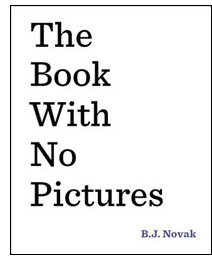 The first item on my list is not an app. It does not require batteries, and no assembly required. It’s a children’s book. Buy it, find a four or five year old child to read it to, and let the fun begin. If you don’t have a young child send it as a gift to someone who does. As an adult, don’t over analyze why this book works for young children. It’s silly, appropriately speaks to its target audience, and it just works. I call this book out because of the disruption it’s caused in the children’s book world, and because it can help teach app developers to think about alternative approaches to content creation. Break outside of self-imposed barriers to creating content in any medium.
The first item on my list is not an app. It does not require batteries, and no assembly required. It’s a children’s book. Buy it, find a four or five year old child to read it to, and let the fun begin. If you don’t have a young child send it as a gift to someone who does. As an adult, don’t over analyze why this book works for young children. It’s silly, appropriately speaks to its target audience, and it just works. I call this book out because of the disruption it’s caused in the children’s book world, and because it can help teach app developers to think about alternative approaches to content creation. Break outside of self-imposed barriers to creating content in any medium.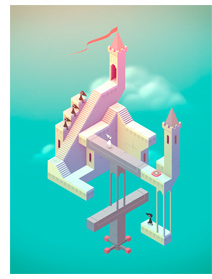 I fell in love with this app earlier in 2014. The artwork is absolutely beautiful, the Escher-esk puzzles are fun and challenging. It did win a KAPi Awards for best app for older kids, but teens and adults will greatly enjoy it as well. It’s only flaw is that the app eventually ends. It’s a game you wish would go on forever. But fear not, the makers of Monument Valley released an additional content download late in the year to extend the challenge with additional levels of play. This app sets the bar very high for the rest of the industry. Currently it’s the yardstick I use to measure against all other apps.
I fell in love with this app earlier in 2014. The artwork is absolutely beautiful, the Escher-esk puzzles are fun and challenging. It did win a KAPi Awards for best app for older kids, but teens and adults will greatly enjoy it as well. It’s only flaw is that the app eventually ends. It’s a game you wish would go on forever. But fear not, the makers of Monument Valley released an additional content download late in the year to extend the challenge with additional levels of play. This app sets the bar very high for the rest of the industry. Currently it’s the yardstick I use to measure against all other apps.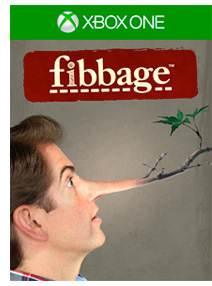 Here’s one you won’t find on any kids list. The game of Fibbage is rated T for Teen, and is a major hit at parties for adults young and old. They’re many things to say about this game. First, do you remember the You Don’t Know Jack titles from years ago? Well, Fibbage was developed by the same creative folks! The game uses a series of fill in the blank phrases, and audience members try to give a response, or a lie, that throws others into voting for your answer. After a short number of rounds the player with the most votes wins. It’s easy to learn, and the humor grows as more people play. But here’s what I really appreciate about this game. In an age of over the top 3D graphics, and deep story lines, and super slick characters and properties, Fibbage is incredibly simple console game, and in a sense a minimalist approach to game play that beats all other games it competes with. It’s also designed to work easily with any kind of smartphone, and you don’t have to be in the same room to play with others. You can have team members from around the world compete with you! Be forewarned there’s crude humor and fart noise throughout. If you can put that aside you will be amazed at how much fun this game is. As a developer, you will appreciate the beauty and simplicity of it’s design.
Here’s one you won’t find on any kids list. The game of Fibbage is rated T for Teen, and is a major hit at parties for adults young and old. They’re many things to say about this game. First, do you remember the You Don’t Know Jack titles from years ago? Well, Fibbage was developed by the same creative folks! The game uses a series of fill in the blank phrases, and audience members try to give a response, or a lie, that throws others into voting for your answer. After a short number of rounds the player with the most votes wins. It’s easy to learn, and the humor grows as more people play. But here’s what I really appreciate about this game. In an age of over the top 3D graphics, and deep story lines, and super slick characters and properties, Fibbage is incredibly simple console game, and in a sense a minimalist approach to game play that beats all other games it competes with. It’s also designed to work easily with any kind of smartphone, and you don’t have to be in the same room to play with others. You can have team members from around the world compete with you! Be forewarned there’s crude humor and fart noise throughout. If you can put that aside you will be amazed at how much fun this game is. As a developer, you will appreciate the beauty and simplicity of it’s design.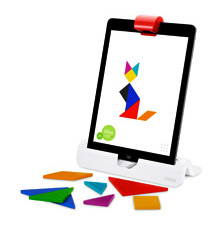 Interactive products that successfully marry together fun interactivity software with physical objects can be counted on just one hand. The industry is littered with virtual and digital product combination failures. Osmo, another KAPi Award winner, stands as one of the shining example in this category. The product can be purchased at most Apple retail stores, and comes bundled with physical pieces to play three games, along with the three apps you download for free to play those games. There’s a fun and challenging tangram puzzle, single or multi player spelling games, and a drawing game where you control the direction of falling virtual balls based on what you draw. It’s a clever set of games and I can’t wait to see what new products this company announces in 2015.
Interactive products that successfully marry together fun interactivity software with physical objects can be counted on just one hand. The industry is littered with virtual and digital product combination failures. Osmo, another KAPi Award winner, stands as one of the shining example in this category. The product can be purchased at most Apple retail stores, and comes bundled with physical pieces to play three games, along with the three apps you download for free to play those games. There’s a fun and challenging tangram puzzle, single or multi player spelling games, and a drawing game where you control the direction of falling virtual balls based on what you draw. It’s a clever set of games and I can’t wait to see what new products this company announces in 2015.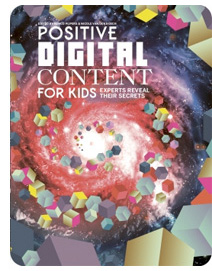 There are two things I really admire together; great design and insightful articles about the interactive industry. This beautifully designed online book includes both! It’s a free, informative guide for developers, complete with excellent interviews from leading children’s product developers like the BBC, Ravensburger, and Toca Boca. Interactive media designers, play designers, and print designers can learn a lot about making successful products and great designs for kids from this book. Another must read for product producers. For me, it was one of the best finds of 2014. Now download a copy and enjoy, but do know the book is also available in a limitedprint run.
There are two things I really admire together; great design and insightful articles about the interactive industry. This beautifully designed online book includes both! It’s a free, informative guide for developers, complete with excellent interviews from leading children’s product developers like the BBC, Ravensburger, and Toca Boca. Interactive media designers, play designers, and print designers can learn a lot about making successful products and great designs for kids from this book. Another must read for product producers. For me, it was one of the best finds of 2014. Now download a copy and enjoy, but do know the book is also available in a limitedprint run.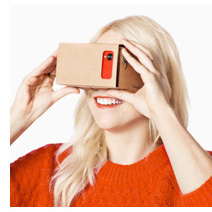 Regardless of what you may think of this deal, the world of virtual reality took a giant step forward in 2014 with the acquisition of Oculus Rift by Facebook. What many people may not be able to see is just how fast the VR space is moving. Google Cardboard is a great example of that breakneck speed. Cardboard is an innovative, low cost solution to experience virtual reality. Folding together a pre-perfed cardboard mailer and sticking your Android compatible phone in the back allows anyone access to a compelling VR experience. The idea itself suggests that a lot can be done with VR in short, affordable bursts. The Google Cardboard initiative is definitely thinking outside the box. Watch for many copycats in the coming months.
Regardless of what you may think of this deal, the world of virtual reality took a giant step forward in 2014 with the acquisition of Oculus Rift by Facebook. What many people may not be able to see is just how fast the VR space is moving. Google Cardboard is a great example of that breakneck speed. Cardboard is an innovative, low cost solution to experience virtual reality. Folding together a pre-perfed cardboard mailer and sticking your Android compatible phone in the back allows anyone access to a compelling VR experience. The idea itself suggests that a lot can be done with VR in short, affordable bursts. The Google Cardboard initiative is definitely thinking outside the box. Watch for many copycats in the coming months.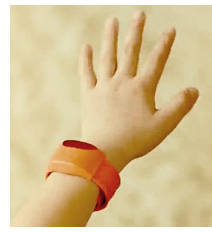 The Moff Band is a set of two flexible wrist bands that communicate motion activity of your arms back to an Apple tablet or smartphone. That motion drives a simple sound effects app. Ever play air drums and wish you could enhance the experience with the perfect set of well orchestrated rhythm effects? Ever have a wooden spoon and needed the audio support to make you feel like you dueling with Zorro? Or maybe a princess’ magic wand is more your style, complete with sparkle sounds? The Moff Band provides a great audio backdrop to your pretend play. The product was a huge Kickstarter success in Japan earlier in the year, and is now just making its way to the US. Watch for it in 2015.
The Moff Band is a set of two flexible wrist bands that communicate motion activity of your arms back to an Apple tablet or smartphone. That motion drives a simple sound effects app. Ever play air drums and wish you could enhance the experience with the perfect set of well orchestrated rhythm effects? Ever have a wooden spoon and needed the audio support to make you feel like you dueling with Zorro? Or maybe a princess’ magic wand is more your style, complete with sparkle sounds? The Moff Band provides a great audio backdrop to your pretend play. The product was a huge Kickstarter success in Japan earlier in the year, and is now just making its way to the US. Watch for it in 2015.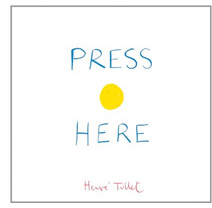 I’ll end my list with another children’s book. Press Here is not just another great children’s book, it’s an excellent example of how to capture the spirit of great interactivity. In a sense it’s a new breed of books, one the feels like the author spent a lot of time studying the world of successful kids apps and theater of the mind, and folded the two into the book’s pages. Anyone working in the industry must experience this book with a child. This is not simply a book for techie wonks. Kids love it. You will love it. It’s a great addition to a young child’s library as well as your professional library.
I’ll end my list with another children’s book. Press Here is not just another great children’s book, it’s an excellent example of how to capture the spirit of great interactivity. In a sense it’s a new breed of books, one the feels like the author spent a lot of time studying the world of successful kids apps and theater of the mind, and folded the two into the book’s pages. Anyone working in the industry must experience this book with a child. This is not simply a book for techie wonks. Kids love it. You will love it. It’s a great addition to a young child’s library as well as your professional library.



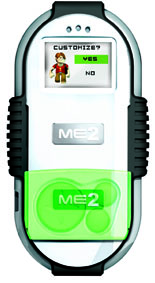 Every year when I attend the New York Toy Fair I may see a few thousand toys in the course of four days. I was recently speaking with another toy reviewer who said, “Did you ever notice that even though you see thousands of new toys, you will only remember maybe five of the best products?” This observation has served me well. What stands out in a Toy Fair attendee’s memory after seeing so many products will usually go on to be the breakthrough later in the year. I believe the ME2 by
Every year when I attend the New York Toy Fair I may see a few thousand toys in the course of four days. I was recently speaking with another toy reviewer who said, “Did you ever notice that even though you see thousands of new toys, you will only remember maybe five of the best products?” This observation has served me well. What stands out in a Toy Fair attendee’s memory after seeing so many products will usually go on to be the breakthrough later in the year. I believe the ME2 by 